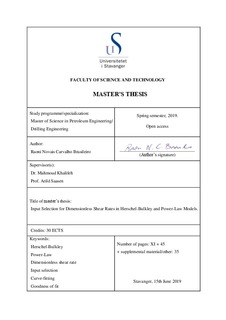| dc.contributor.advisor | Khalifeh, Mahmoud | |
| dc.contributor.advisor | Saasen, Arild | |
| dc.contributor.author | Brasileiro, Raoni | |
| dc.date.accessioned | 2019-12-18T09:27:43Z | |
| dc.date.available | 2019-12-18T09:27:43Z | |
| dc.date.issued | 2019-06 | |
| dc.identifier.uri | http://hdl.handle.net/11250/2633837 | |
| dc.description | Master's thesis in Petroleum Engineering | nb_NO |
| dc.description.abstract | Herschel-Bulkley and Power-Law models are mathematical expressions widely used to describe the pseudoplastic nature of drilling muds. Despite their popularity, these models carry an intrinsic limitation because the consistency index is a function of the flow behavior index. Some works have proposed the use of dimensionless shear rates to overcome this issue. However, this solution requires two inputs, which are taken from the experimental data set. The bigger the number of experimental points is, the bigger the number of input combinations becomes. Moreover, the selection of such points is not a self-evident task and relies heavily on one’s experience. | nb_NO |
| dc.description.abstract | This thesis presents: first, a methodology from which two objective approaches for selection of inputs were derived; second, a MATLAB code that enables curve-fitting of rheological data and some hydraulic calculations. These techniques were meant to balance computation time and goodness of fit. Non-linear regression, which is the best solution in terms of goodness of fit, was taken as a benchmark and was compared to the two proposed approaches. Rheological characterization and hydraulic calculations were performed for different recipes of oil-based mud (OBM) and polyanionic cellulose (PAC) solution. For the fluid modeled by Power-Law model, hydraulic predictions had an error of 3% at most, whereas the computing time was only about 5% of the non-linear’s in the worst case. For the fluid modeled by Herschel-Bulkley model and flow rates greater than approximately 600 l/min, these values were, respectively, 5% and 1%. Therefore, the proposed approaches are extremely faster than a non-linear regression at a relatively low cost in terms of accuracy loss. Moreover, it was shown how the use of a single iteration can increase the goodness of fit in the dimensionless shear rate approach and how error propagation theory can be applied to the dimensionless Power-Law model. | nb_NO |
| dc.description.abstract | Finally, the methodology and the MATLAB code contributed to a SPE Conference Paper that explored the impact of Power-Law model parameters on frictional pressure loss uncertainty. | nb_NO |
| dc.language.iso | eng | nb_NO |
| dc.publisher | University of Stavanger, Norway | nb_NO |
| dc.relation.ispartofseries | Masteroppgave/UIS-TN-IEP/2019; | |
| dc.rights | Navngivelse 4.0 Internasjonal | * |
| dc.rights.uri | http://creativecommons.org/licenses/by/4.0/deed.no | * |
| dc.subject | petroleumsteknologi | nb_NO |
| dc.subject | petroleum engineering | nb_NO |
| dc.subject | boreteknologi | nb_NO |
| dc.subject | Herschel-Bulkley | nb_NO |
| dc.subject | Power-Law | nb_NO |
| dc.subject | dimensionless shear rate | nb_NO |
| dc.subject | input selection | nb_NO |
| dc.subject | curve-fitting | nb_NO |
| dc.subject | goodness of fit | nb_NO |
| dc.title | Input Selection for Dimensionless Shear Rates in Herschel-Bulkley and Power-Law Models | nb_NO |
| dc.type | Master thesis | nb_NO |
| dc.subject.nsi | VDP::Technology: 500::Rock and petroleum disciplines: 510::Petroleum engineering: 512 | nb_NO |

